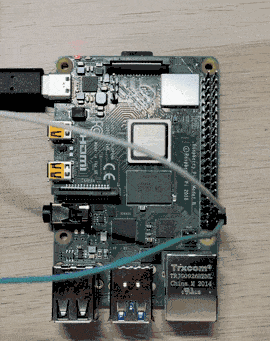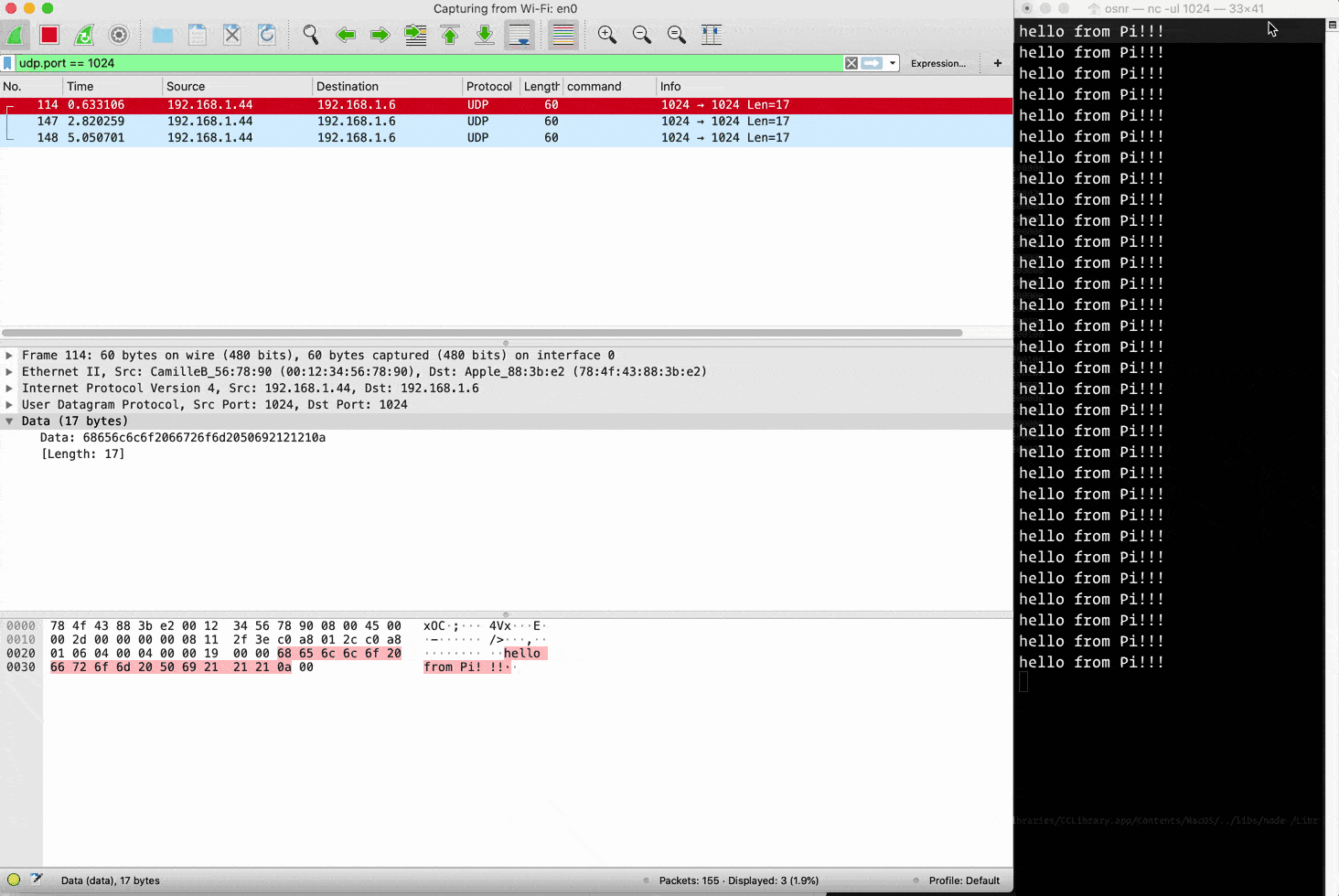I recently learned that sending UDP packets over 10BASE-T Ethernet is actually not that complicated, so I wanted to try it.
In particular, after seeing how little code it is on an FPGA, I wanted to reimplement it in C to understand it better / maybe ultimately prototype more ideas / prototype better ways to represent it. (I'm capable of thinking in C but not in Verilog, yet. And that fpga4fun example is pretty dense & inlined; reading the code doesn't tell you much about the protocols. Other examples online are mostly assembly for constrained platforms, equally dense in their own ways.)
The Raspberry Pi 4 is fast enough to bit-bang Ethernet comfortably (far above 20MHz).
I don't like doing stuff like this in Linux, and it sort of defeats the point of doing it from scratch, and it's even harder to nail the timing if you have interrupts and other processes and a kernel flying around, so we'll do it on bare metal. It's more fun, anyway.
It seems clear that this approach, a few hundred lines of C and ARM assembly that tightly fits the Ethernet/IP/UDP protocols and pokes at some registers to toggle GPIO pins, is actually less total code and more understandable than using the actual Ethernet port on the Pi, which requires a full USB stack :-/
This project is more of a byproduct of me trying to understand Ethernet & that FPGA example rather than a project that's meant to be used :-) It also doubles as a simple-ish template for bare-metal programming for the Pi 4. (see also valvers.com) I expect I'll use it as a starter for other stuff and as documentation so my future self can relearn how I did these things.
Warning: All sources say this is pretty sketchy and out of spec for Ethernet, so you might fry something: your Pi, your router, etc. We're sending 3.3V logic when they say you shouldn't go above 2.8V. Magnetics stuff isolates the device if you use a real Ethernet jack. (I think you could buy a MagJack on its own? Maybe that'd be sufficient.) In particular, I think you should not do this with a Power over Ethernet port on the other side.
I've only tested this on a single Raspberry Pi 4B with 2GB RAM. (I don't see why it wouldn't work on other Pi 4B models; it might even be workable on the Pi 2 or 3, although you'd need to mess a lot with the timings there and change all the 0xFE... memory addresses.)
You'll need the gcc-arm-none-eabi toolchain installed on your computer.
- Cut open an Ethernet cable (or use a breakout board), and connect pins 1 (green-and-white) and 2 (plain green) of the Ethernet cable to GPIO pins 20 and 21 on the Pi (on the bottom right), respectively.
-
Get a microSD card and format it to FAT. Copy the firmware
start4.elfto the root of the SD card. (I think this is the only file, other than our binary, that you need on the card on the Pi 4, unless you want to use JTAG or get more RAM or clock speed or something.) -
Edit
rpi-bitbang-ethernet.cand put your computer's IP address and MAC address in. -
Compile:
$ make
-
Copy
rpi-bitbang-ethernet.binto the root of the SD card and rename it tokernel7l.img. -
Run
nc -ul 1024in a terminal on your computer and leave it on; the UDP packet from the Pi should show up here after the next step. -
Put the SD card in your Pi and power it on. If the program is running OK, the green ACT LED should toggle every 2 seconds or so.
-
Connect the other end of the cable to your Ethernet switch (or to a computer directly -- the link says you should crossover and use pins 3 and 6 in this case, but I haven't found that to be necessary with modern hardware. Pins 1 and 2 seem fine).
Now you should (usually) see the packet show up on your computer each time the green LED toggles! I have Wireshark open here, so you can see how the whole Ethernet frame looks:
Check out, for instance, how the source MAC address is 00:12:34:56:78:90, a value I basically made up and stuck in the code.
You really only need to look at rpi-bitbang-ethernet.c and transmit.s. I construct a buffer containing the proper Ethernet, IP, and UDP headers and the payload, then toggle the GPIO pins with the right timing to transmit it.
You might find writeup on development/debugging techniques & tools interesting.
MIT
-
ethertiny (Bit-banging Ethernet On An ATTiny85 has a great video with explanation)
-
fpga4fun.com 10BASE-T FPGA interface: the best 'hacker's explanation' of Ethernet I found. I only started this project after I realized their thing worked on my network (used an ECP5 FPGA I had lying around), so I had a known-good example -- if you can't get this project working, it might be wise to check that theirs works
-
IgorPlug-UDP: I didn't really look at this, but it's cited around various places if you look for stuff about bit-banging Ethernet.
-
10Base-T Medium Attachment Unit PDF: very clear explanations of timing, has good diagram
What's new here vs. these projects, maybe: The Pi is fast enough and big enough that we can write mostly in C and have proper structs for all the network headers, which results in (I think) much clearer and more educational code, something you could imagine actually turning into a coherent (if hacky and personal-use-only) network stack.
(vague)
Make the packet vary! Based on GPIO pin input? It is a little sad to just send a fixed packet. It feels like I'm betraying the spirit of the programmable computer, which is supposed to take input and change over time. This thing might as well be a fixed circuit.
Internet! Maybe this would just work out of the box? it does work!
it sends fine over Internet :D
Receive packets! You might need to do more physical analog stuff to make it work, but I don't think the digital part would be too bad, since the Pi is so much faster than the 10BASE-T clock? You could just sit on the wire and sample really fast and look for level changes.
I wonder if you could run this in Linux by dedicating a core to it. Could you get it to interface with the OS and act as a NIC? Might be a fun way to learn about driver development.
"Could you make a working DHCP server by soldering wires from a CAT5 cable straight onto an ICE40 FPGA?" / "You can do 100base-TX with a Spartan-6 and a dozen resistors"
TCP!
I guess there's something that I feel drawn to about using a tiny amount of code to interoperate with a giant, complicated, modern system -- because the system still understands the dead simple 1970s protocol at heart.
I also like the idea of leapfrogging what would have had to be custom hardware in the old days using the combination of simple code and an overkill modern CPU.
I think it would be cool to make a radically small OS with graphics, networking, and so on, where you just dedicate cores to bit-bang each of them. All the parts of computing that are interesting and fun without any of the boring and arbitrary peripheral setup code / the essential complexity of protocols instead of the inessential complexity of drivers



